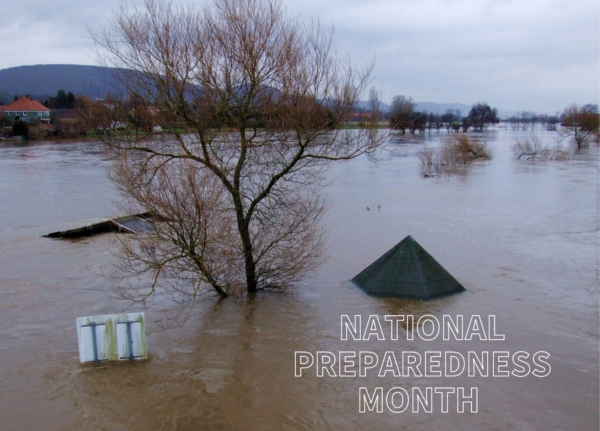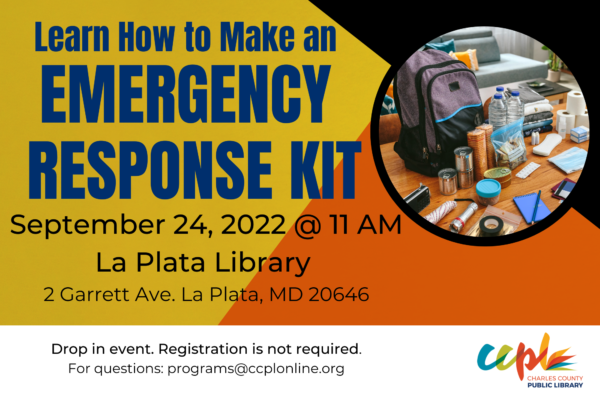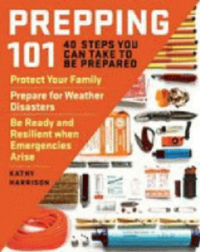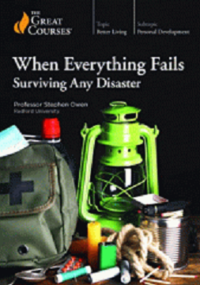
Does your family have an emergency plan? Have you discussed how you will communicate and reconnect if you are separated during an emergency? Have you shared your plan with relatives and close friends? The Department of Homeland Security has designated September as National Preparedness Month. Take time now to create or update a plan for your family in the event of a disaster. See Make A Plan | Ready.gov to learn how.
There are three basic steps to creating your emergency plan. First, have a discussion with your family about possible emergency situations you may encounter. Think of ways you can prepare for those situations and how to respond to them. Next, identify which family members will be responsible for specific tasks. Then, be sure to practice so that you can remain calm in the face of an actual emergency.
According to The Most Common Natural Disasters Across The US | Red Cross , the most likely natural disasters in our area include hurricanes and winter storms. September is the most active month for hurricanes. Your family should have a plan for evacuating, if told to do so, and a plan for sheltering in place. See the Red Cross’s Hurricane Information Sheet to learn how to stay safe before, during, and after a hurricane. Your family plan for winter storms should include ways to protect your family (including pets) and your home. These storms can last a few hours or several days and can knock out power (including heat and electricity), as well as communications. See the Red Cross’s Be prepared for a winter storm to learn how to prepare for and stay safe during a winter storm.
The American Red Cross has a free Family Disaster Plan template. Download and complete the template. Keep a copy on your computer to be revised and updated regularly, email a copy to relatives and close friends, and print paper copies for yourself and your family. Keep a copy in your bag or backpack, car, office, and/or disaster kit. Also provide each family member a copy of your Family Communication Plan which details important family and medical information.
It is wise to assemble a disaster kit composed of essential supplies ahead of time. Be sure to include enough food and water for three days, a gallon of water per person per day, as well as medical, baby, and pet supplies. For a list of other important items to include, see What Do You Need In a Survival Kit | American Red Cross or Build A Kit | Ready.gov.
With your family, discuss any special considerations for family members who are elderly or have disabilities. Emergency Preparedness for Older Adults and People with Disabilities describes important things to consider when planning, such as communicating important medical information and sharing effective strategies for assisting those with disabilities.
To engage children and teens in the planning process, Games | Ready.gov has developed a series of games to test preparedness knowledge. Be sure to check out the other related resources on the web page for further information on emergency preparedness.
Join us at the La Plata Library on September 24th at 11 AM for the presentation:
Learn How to Create an Emergency Response Kit!
Check out CCPL’s Catalog for more resources on preparing for emergencies. Here are a few titles to get you started.
Prepping 101: 40 Steps You Can Take to Be Prepared by Kathy Harrison
40 practical, easy-to-implement steps to protect your home, family, and pets during short- and long-term emergencies.
When Everything Fails by Stephen Owen
Living through a disaster is not a question of if, it’s a question of when. This lecture offers a practical guide for protecting the individual, their family, and their community. Taught by Professor Stephen Owen of Radford University, these fourteen fast-paced lectures will arm viewers with information for planning ahead so they can prepare for the effects of a disaster or catastrophe.
The Prepared Home by Melissa George
Whether there’s a power outage, the wi-fi goes out, or you are asked to quarantine, you should have plans and preparedness goals that don’t take over your space and your life. George providea guide to help you transform your home from entertaining mode to disaster-ready mode, using clever ways to store emergency items. Your home is your sanctuary– it should be a place of safety, comfort, and beauty!









